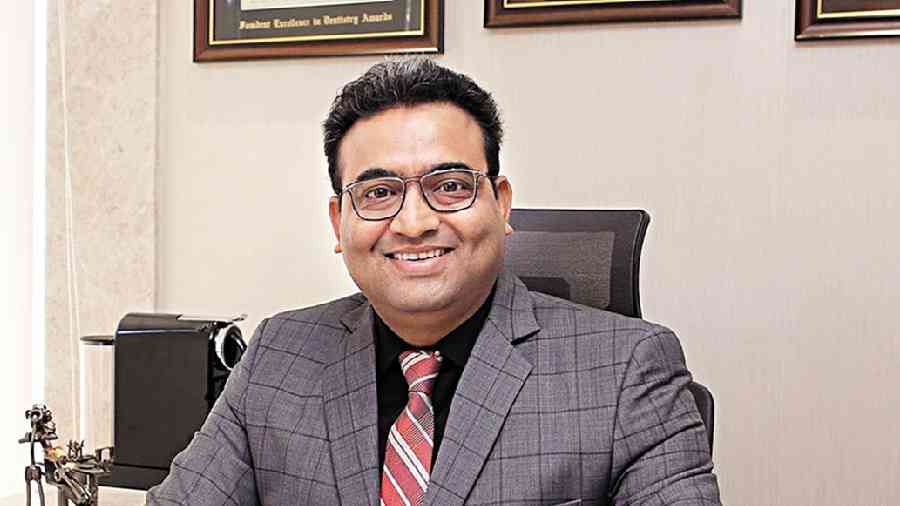The earliest proverbial crystal ball was probably the mirror that replied to the ultimate vanity question: “Mirror, mirror on the wall, who is the fairest of all?”
This question symbolised the never-ending quest for beauty and the desire for perennial charm. Fast forward to the 21st century and we have tools now which can consistently and predictably quench the thirst for desired dental aesthetics and an elegant smile. The advent of 3D printing and AI (artificial intelligence) algorithms has completely revolutionised dentistry and has given birth to a new stream termed “digital dentistry”.
The ability to choose the smile one wants, with the added advantage of being able to see the results before starting any treatment are the hallmark of these technologies, in addition to increasing the speed and accuracy of the results.
Designer smiles in dentistry refer to cosmetic dental procedures aimed at improving the appearance of a person’s smile. These procedures are often elective and can improvise a range of treatments, such as teeth whitening, dental veneers, crooked teeth realignment, gap closure between teeth, keyhole dental implants, orthodontics, invisible braces (clear aligners), gum reshaping, cosmetic jaw surgery and smile correction.
The tools used to make patients’ cosmetic desires come alive are intra-oral scanners, 3D printing, simulation software powered by artificial intelligence, and robots which perform certain surgeries.
Intra-oral scanners
Intra-oral scanners are devices which accurately capture entire data of teeth, gums and mouth in a colour 3D format to create a highly accurate 3D model of the patient’s mouth. This digital model can then be used to design and manufacture with a high degree of precision artificial life-like constructs which the patient desires.
The scan also allows for the creation of highly customised orthodontic devices, such as clear aligners, that are tailored to the specific needs of individual patients. Scans are great visual interactive tools that enhance patient education and communication. One can look at their dental issues in a high-resolution format and clearly understand the problems and how to solve them.
Intra-oral scanners have a number of advantages.
Creating digital impressions: Intraoral scanners allow dental professionals to take digital impressions of a patient’s teeth and gums without the need for traditional putty or silicone impression materials. This can make the process faster, more comfortable, and less messy for patients.
Orthodontic treatment planning: Intra-oral scanners can be used to create digital models of a patient’s teeth, which can then be used to plan and design orthodontic treatments, such as braces or aligners. Adults can benefit from invisible braces to correct their teeth alignmentRestorative dentistry: Intraoral scanners can help dentists create highly accurate digital models of a patient’s teeth, which can be used to design and create restorations, such as crowns, bridges, and veneers.Implant planning and placement: Intra-oral scanners can be used to create precise digital images of a patient’s jawbone and surrounding oral structures, which can be used to plan and place dental implants.
3D Printing
3D printing is a manufacturing process that creates a physical object from a digital model file. The technology works by adding layer upon layer of material to build up a complete object. This helps in
Customisation: With 3D printing, dental appliances can be customised to fit each patient’s unique dental anatomy. This allows for better fit and comfort and can improve the overall aesthetics of a smile.Reduced waste: 3D printing uses only the amount of material needed to create the dental appliance, which reduces waste and helps to keep costs down.Improved Patient Experience: 3D printing allows for a more efficient and streamlined dental workflow, which can improve the patient experience. Patients can receive their custom-made dental appliances faster, with fewer visits to the dentist.Enhanced communication: 3D printing technology enables dentists to communicate more effectively with patients, other dental professionals and the manufacturing labs which make artificial customised teeth. Dentists can use 3D models to demonstrate treatment options, helping patients to better understand their options and take more informed decisions.
Simulation software
Digital smile designing (DSD) is a dental treatment planning tool that uses digital technology to enhance a patient’s smile. This approach allows dentists to design and simulate a patient’s new smile before treatment, providing a preview of the final result.
First, the dentist will take photographs and videos of the patient’s face and smile. Then, these images are uploaded into specialised software, where the dentist can use digital tools to adjust the size, shape, and position of the teeth to create the desired smile.
Once the digital design is complete, the dentist can use the information to create a customised treatment plan for the patient. This may involve a combination of procedures such as dental implants, teeth whitening, or veneers. The dentist can also create a mock-up or temporary restoration that allows the patient to visualise the final result.
Digital smile designing offers several benefits for both the patient and the dentist. Patients can see the potential results of their treatment before it begins, which can help them feel more confident and comfortable with the process. Dentists can use the digital design to communicate treatment goals and expectations with the patient, leading to more precise and predictable treatment outcomes.

Artificial Intelligence
Artificial intelligence (AI) is revolutionising many fields, and dentistry is no exception. Here are some of the ways in which AI is changing dentistry.
Improved diagnosis: AI is being used to improve the accuracy of dental diagnoses. AI algorithms can analyse dental images and detect issues like cavities, fractures, and gum disease at an early stage, which can lead to faster treatment and better outcomes.Treatment planning: AI is being used to help dentists plan complex treatments. For example, AI algorithms can help dentists create customised treatment plans for patients with complex dental issues, such as tooth loss or misalignment.Predictive analytics: AI can analyse large amounts of dental data to predict the likelihood of certain dental conditions developing in patients. This can help dentists identify patients who are at a higher risk of developing dental issues and take preventative measures to reduce the risk.Patient monitoring: AI is being used to monitor patients’ oral health over time. For example, AI algorithms can analyse images of a patient’s teeth and gums to track changes in their oral health over time, and alert dentists to potential issues.Automated image analysis: AI can analyse dental images and identify potential issues that may not be visible to the naked eye. This technology can help dentists catch potential problems early and prevent more serious issues from developing.Personalised treatment recommendations: AI can analyse large datasets of patient records to identify patterns and trends in orthodontic treatment outcomes. This can help orthodontists to make personalised treatment recommendations based on a patient’s specific needs and goals.
Robotics
AI is being used to control dental robots that can assist dentists during procedures. These robots can perform certain tasks more accurately and efficiently than human dentists, allowing for faster and more precise treatments.
Together, 3D printing and AI smile designing are providing dentists with powerful tools to create personalised and precise dental restorations that enhance the overall patient experience. These technologies are likely to continue to evolve and have a significant impact on the field of dentistry in the years to come.

Dr Kamlesh Kothari is an Oral and Maxillofacial Surgeon with a special focus on advanced dental and maxillofacial implantology. He is the director of Aesthetica - Advanced Dental and implant clinic at Vasundhara, 2/7 Sarat Bose Road, Calcutta. He can be reached at 9830183000, drkamleshkothari@gmail.com or www.aesthetica.co.in






